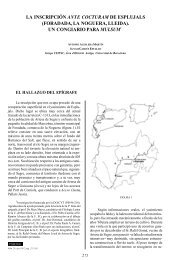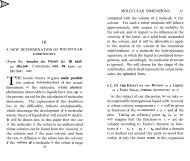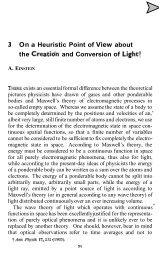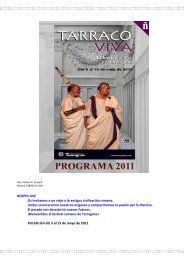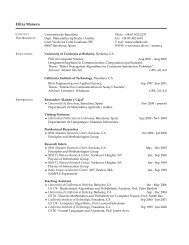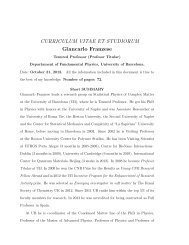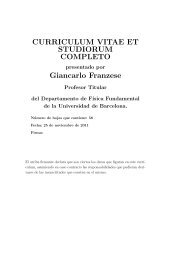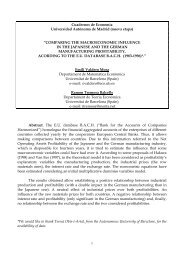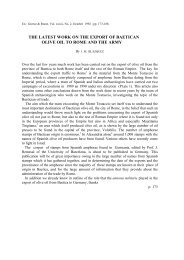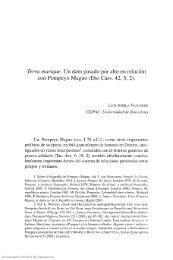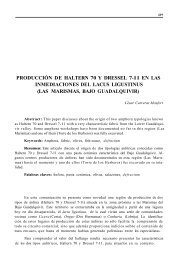Spinning Electrons and the Structure of Spectra
Spinning Electrons and the Structure of Spectra
Spinning Electrons and the Structure of Spectra
You also want an ePaper? Increase the reach of your titles
YUMPU automatically turns print PDFs into web optimized ePapers that Google loves.
Spin<strong>Spinning</strong> <strong>Electrons</strong> <strong>and</strong> <strong>the</strong> <strong>Structure</strong> <strong>of</strong> <strong>Spectra</strong>Nature, vol. 117, p. 264-265February 20, 1926So far as we know, <strong>the</strong> idea <strong>of</strong> a quantised spinning <strong>of</strong> <strong>the</strong> electron was put forward for <strong>the</strong> first time byA.K. Compton (Jour. Frankl. Inst., Aug. 1921 p. 145 ), who pointed out <strong>the</strong> possible bearing <strong>of</strong> this ideaon <strong>the</strong> origin <strong>of</strong> <strong>the</strong> natural unit <strong>of</strong> magnetism. Without being aware <strong>of</strong> Compton's suggestion, we havedirected attention in a recent note (Naturwissenschaften, Nov. 20, 1925 ) to <strong>the</strong> possibility <strong>of</strong> applying<strong>the</strong> spinning electron to interpret a number <strong>of</strong> features <strong>of</strong> <strong>the</strong> quantum <strong>the</strong>ory <strong>of</strong> <strong>the</strong> Zeeman effect, whichwere brought to light by <strong>the</strong> work especially <strong>of</strong> van Lohuizen, Sommerfeld, L<strong>and</strong>é <strong>and</strong> Pauli, <strong>and</strong> also <strong>of</strong><strong>the</strong> analysis <strong>of</strong> complex spectra in general.In this letter we shall try to show how our hypo<strong>the</strong>sis enablesus to overcome certain fundamental difficulties which have hi<strong>the</strong>rto hindered <strong>the</strong> interpretation <strong>of</strong> <strong>the</strong>results arrived by those authors.To start with, we shall consider <strong>the</strong> effect <strong>of</strong> <strong>the</strong> spin on <strong>the</strong> manifold <strong>of</strong> <strong>the</strong> stationary states whichcorresponds to motion <strong>of</strong> an electron round a nucleus. On account <strong>of</strong> it's magnetic moment,<strong>the</strong> electronwill be acted on by a couple just as if it were placed at rest in a magnetic field <strong>of</strong> magnetic field <strong>of</strong>magnitude equal to <strong>the</strong> vector product <strong>of</strong> <strong>the</strong> nuclear electric fields <strong>and</strong> velocity <strong>of</strong> <strong>the</strong> electron relative to<strong>the</strong> nucleus divided by <strong>the</strong> velocity <strong>of</strong> light. This couple will cause a slow precession <strong>of</strong> <strong>the</strong> spin axis, <strong>the</strong><strong>the</strong> conservation <strong>of</strong> <strong>the</strong> angular momentum <strong>of</strong> <strong>the</strong> atom being ensured by a compensating precession <strong>of</strong><strong>the</strong> orbital plane <strong>of</strong> <strong>the</strong> electron. This complexity <strong>of</strong> <strong>the</strong> motion requires that, corresponding to eachstationary state <strong>of</strong> an imaginary atom, in which <strong>the</strong> electron has no spin, <strong>the</strong>re shall in general exist a set<strong>of</strong> states which differ in <strong>the</strong> orientation <strong>of</strong> <strong>the</strong> spin axis relative to <strong>the</strong> orbital plane, <strong>the</strong> o<strong>the</strong>rcharacteristics <strong>of</strong> <strong>the</strong> motion remaining unchanged. If <strong>the</strong> spin corresponds to a one quantum rotation,<strong>the</strong>re will be in general two such states. Fur<strong>the</strong>r, <strong>the</strong> energy difference <strong>of</strong> <strong>the</strong>se states. Fur<strong>the</strong>r, <strong>the</strong> energydifference <strong>of</strong> <strong>the</strong>se states will, as a simple calculation shows, be proportional to <strong>the</strong> fourth power <strong>of</strong> <strong>the</strong>nuclear charge. It will also depend on <strong>the</strong> quantum numbers which define <strong>the</strong> state <strong>of</strong> motion <strong>of</strong> <strong>the</strong> nonspinningelectron in a way very similar to <strong>the</strong> energy differences connected with <strong>the</strong> rotation <strong>of</strong> <strong>the</strong> orbitin its own plane arising from <strong>the</strong> relativity variation <strong>of</strong> <strong>the</strong> electronic mass. We are indebted to Dr.Heisenberg for a letter containing some calculations on <strong>the</strong> quantitative side <strong>of</strong> <strong>the</strong> problem.http://dbhs.wvusd.k12.ca.us/Chem-History/Uhlenbeck-Goudsmit-spin.html (1 <strong>of</strong> 5) [23/08/2002 13:02:06]
SpinThis results suggests an essential modification <strong>of</strong> <strong>the</strong> explanation hi<strong>the</strong>rto given <strong>of</strong> <strong>the</strong> fine structure <strong>of</strong><strong>the</strong> hydrogen-like spectra. As an illustration we may consider <strong>the</strong> energy levels corresponding toelectronic orbits for which <strong>the</strong> principal quantum number is equal to three. The scheme on <strong>the</strong> left side <strong>of</strong><strong>the</strong> accompanying figure (Fig. 1) corresponding to <strong>the</strong> results to be expected from Sommerfeld's <strong>the</strong>ory.The so called azimuthal quantum number k is defined by <strong>the</strong> quantity <strong>of</strong> moment <strong>of</strong> momentum <strong>of</strong> <strong>the</strong>electron about <strong>the</strong> nucleus, kh/2π, where k = 1, 2, 3. According to <strong>the</strong> new <strong>the</strong>ory, depicted in <strong>the</strong>scheme 1 on <strong>the</strong> right, 1 Quite independently <strong>of</strong> <strong>the</strong> ideas discussed here, a scheme <strong>of</strong> levelscorresponding to this figure has been previously proposed by <strong>the</strong> writers (Physics, 5, 266, 1925), on <strong>the</strong>ground <strong>of</strong> <strong>the</strong> formal analogy between spectral structures. From similar formal considerations, thisscheme has recently also been arrived at by J.C. Slater (Proc. Washington Acad., December 1925).this moment <strong>of</strong> momentum is given by Kh / 2π, where K = 1/2, 5/2, 5/2. The total angular momentum <strong>of</strong>http://dbhs.wvusd.k12.ca.us/Chem-History/Uhlenbeck-Goudsmit-spin.html (2 <strong>of</strong> 5) [23/08/2002 13:02:06]
Spin<strong>the</strong> atom is Jh/2π, where J = 1, 2, 3. The symbols K <strong>and</strong> J correspond to those used by L<strong>and</strong>é in hisclassification <strong>of</strong> <strong>the</strong> Zeeman effects <strong>of</strong> <strong>the</strong> optical spectra which we consider below. The dotted linesrepresent <strong>the</strong> position <strong>of</strong> <strong>the</strong> energy levels to be expected in <strong>the</strong> absence <strong>of</strong> <strong>the</strong> spin <strong>of</strong> <strong>the</strong> electron. As <strong>the</strong>arrows indicated, this spin now spits each levels into two, with <strong>the</strong> exception <strong>of</strong> <strong>the</strong> level K= 1/2, whichis only displaced.In order to account for <strong>the</strong> experimental facts, <strong>the</strong> resulting levels must fall in must fall in just <strong>the</strong> sameplaces as <strong>the</strong> levels given by <strong>the</strong> older <strong>the</strong>ory. Never<strong>the</strong>less, <strong>the</strong> two schemes differ fundamentally. Inparticular, <strong>the</strong> new <strong>the</strong>ory explains at once <strong>the</strong> occurrence <strong>of</strong> certain components in <strong>the</strong> fine structure <strong>of</strong><strong>the</strong> hydrogen spectrum <strong>and</strong> <strong>of</strong> <strong>the</strong> helium spark spectrum which according to <strong>the</strong> old scheme wouldcorrespond to transitions where K remains uncharged. Unless <strong>the</strong>se transitions could me ascribed to <strong>the</strong>action <strong>of</strong> electric forces in <strong>the</strong> discharge which would perturb <strong>the</strong> electronic motion, <strong>the</strong>ir occurrencewould be in disagreement with <strong>the</strong> correspondence principle, which only allows transitions in which <strong>the</strong>azimuthal quantum number changes by one unit <strong>and</strong> only J will remain unchanged. Their occurrence is,<strong>the</strong>refore, quite in conformity with <strong>the</strong> correspondence principle.The modification proposed is specially important for explaining <strong>the</strong> structure <strong>of</strong> X - ray spectra. Thesespectra differ from <strong>the</strong> hydrogen-like spectra by <strong>the</strong> appearance <strong>of</strong> so called "screening" doublets, whichare ascribed to <strong>the</strong> interactions <strong>of</strong> electrons within <strong>the</strong> atom, effective mainly through reducing <strong>the</strong> effect<strong>of</strong> nuclear attraction. In our view, <strong>the</strong>se screening doublets correspond to pair <strong>of</strong> levels which have <strong>the</strong>same angular momentum J but different azimuthal quantum numbers K. Consequently, <strong>the</strong> orbits willpenetrate to different distances from <strong>the</strong> nucleus, so that <strong>the</strong> screening <strong>of</strong> <strong>the</strong> nuclear charge by <strong>the</strong> o<strong>the</strong>relectrons in <strong>the</strong> atom will have different effects. This screening effect will, however, be <strong>the</strong> same for apair <strong>of</strong> levels which have <strong>the</strong> same K but different J's <strong>and</strong> correspond to <strong>the</strong> same orbital shape. Suchpairs <strong>of</strong> levels were, on <strong>the</strong> older <strong>the</strong>ory, labeled with values <strong>of</strong> k different by one unit, <strong>and</strong> it was quiteimpossible to underst<strong>and</strong> why <strong>the</strong>se so called " relativity " doublets should appear separately from <strong>the</strong>screening doublets. On our view, <strong>the</strong> doublets in question may more properly be termed "spin" doublets,since <strong>the</strong> sole reason for <strong>the</strong>ir appearance is <strong>the</strong> difference in <strong>the</strong> orientation <strong>of</strong> <strong>the</strong> spin axis relative to<strong>the</strong> orbital plane. It should be emphasized that our interpretation is in complete accordance with <strong>the</strong>correspondence principle as regards <strong>the</strong> rules <strong>of</strong> combination <strong>of</strong> X- ray levels.The assumption <strong>of</strong> <strong>the</strong> spinning electron leads to a new insight into <strong>the</strong> remarkable analogy between <strong>the</strong>multiplet structure <strong>of</strong> <strong>the</strong> optical spectra <strong>and</strong> <strong>the</strong> structure <strong>of</strong> <strong>the</strong> X - ray spectra, which was emphasizedespecially by L<strong>and</strong>é <strong>and</strong> Millikan. While <strong>the</strong> attempt to refer this analogy to a relatively effect commonto all <strong>the</strong> structures was most unsatisfactory, it obtains an immediate explanation on <strong>the</strong> hypo<strong>the</strong>sis <strong>of</strong> <strong>the</strong>spin electron. If, for example, we consider <strong>the</strong> spectra <strong>of</strong> <strong>the</strong> alkaline type, we are led to recognise in <strong>the</strong>well known doublets regular spin doublets <strong>of</strong> <strong>the</strong> character described above. In fact, this enables us toexplain <strong>the</strong> dependence <strong>of</strong> <strong>the</strong> doublet width on <strong>the</strong> effective nuclear charge <strong>and</strong> <strong>the</strong> quantum numbersdescribing <strong>the</strong> orbit, as well as <strong>the</strong> rules <strong>of</strong> combination.The simplicity <strong>of</strong> <strong>the</strong> alkaline spectra is due to <strong>the</strong> fact that <strong>the</strong> atom consists <strong>of</strong> an electron revolvinground an atomic residue which contains only completed electronic groups, which are magnetically inert.When we pass to atoms in which several electrons revolve round a residue <strong>of</strong> this kind we meet with newhttp://dbhs.wvusd.k12.ca.us/Chem-History/Uhlenbeck-Goudsmit-spin.html (3 <strong>of</strong> 5) [23/08/2002 13:02:06]
Spinfeatures since we have to take account <strong>of</strong> o<strong>the</strong>r directing influences on <strong>the</strong> spin axis <strong>of</strong> each electronbesides <strong>the</strong> couple due to its own motion in <strong>the</strong> electric field. Not only does this enable us to account for<strong>the</strong> appearance <strong>of</strong> multiplets <strong>of</strong> higher complexity, but it also seems to throw light on <strong>the</strong> so-called"branching" <strong>of</strong> spectra, which usually accompanies <strong>the</strong> adding <strong>of</strong> a fur<strong>the</strong>r electron to <strong>the</strong> atom, <strong>and</strong> forwhich hi<strong>the</strong>rto no satisfactory explanation has been given. In fact it seems that <strong>the</strong> introduction <strong>of</strong> <strong>the</strong>concept <strong>of</strong> <strong>the</strong> spinning electron makes it possible throughout to maintain <strong>the</strong> principle <strong>of</strong> <strong>the</strong> successivebuilding up <strong>of</strong> atoms utilised by Bohr in his general discussion <strong>of</strong> <strong>the</strong> relations between spectra <strong>and</strong> <strong>the</strong>natural system <strong>of</strong> <strong>the</strong> elements. Above all, it may be possible to account for <strong>the</strong> important results arrivedat by Pauli, without having to assume an unmechanical "duality" in <strong>the</strong> binding <strong>of</strong> <strong>the</strong> electrons.So far we have not mentioned <strong>the</strong> Zeeman effect, although <strong>the</strong> introduction <strong>of</strong> <strong>the</strong> spinning electron wasprimarily suggested by <strong>the</strong> analysis <strong>of</strong> <strong>the</strong> anomalous Zeeman effects shown by <strong>the</strong> components <strong>of</strong>multiplet structures. From <strong>the</strong> point <strong>of</strong> view <strong>of</strong> <strong>the</strong> correspondence principle, this effect shows that <strong>the</strong>influence <strong>of</strong> a magnetic field on <strong>the</strong> motion <strong>of</strong> <strong>the</strong> atom differs considerably form that to be expected if<strong>the</strong> electron had no spin. In fact, from <strong>the</strong> well-known <strong>the</strong>orem <strong>of</strong> Larmor we would expect <strong>the</strong> effect onany spectral line to be one <strong>of</strong> <strong>the</strong> simple Lorentz type, quite independently <strong>of</strong> <strong>the</strong> character <strong>of</strong> <strong>the</strong>multiplet structure. Therefore <strong>the</strong> appearance <strong>of</strong> <strong>the</strong> anomalous Zeeman effects has hi<strong>the</strong>rto presentedvery grave difficulties. However, <strong>the</strong>se difficulties disappear at once when as assumed, <strong>the</strong> electron has aspin <strong>and</strong> <strong>the</strong> ration between magnetic moment <strong>and</strong> angular momentum <strong>of</strong> this spin is different from thatcorresponding to <strong>the</strong> revolution <strong>of</strong> <strong>the</strong> electron in an orbit large compared with its own size. On thisassumption <strong>the</strong> spin axis <strong>of</strong> an electron not affected by o<strong>the</strong>r forces would precess with a frequencydifferent from <strong>the</strong> Larmor rotation. It is easily shown that <strong>the</strong> resultant motion <strong>of</strong> <strong>the</strong> atom for magneticfields <strong>of</strong> small intensity will be <strong>of</strong> just <strong>the</strong> type revealed by L<strong>and</strong>é's analysis. If <strong>the</strong> field is so strong thatits influence on <strong>the</strong> precession <strong>of</strong> <strong>the</strong> spin axis is comparable with that due to <strong>the</strong> orbital motion in <strong>the</strong>atom, this motion will be charged in a way which directly explains <strong>the</strong> gradual transformation <strong>of</strong> <strong>the</strong>multiplet structure for increasing fields known as <strong>the</strong> Paschen-Back effect.It seems possible on <strong>the</strong>se lines to develop a quantitative <strong>the</strong>ory <strong>of</strong> <strong>the</strong> Zeeman effect, if it is assumed that<strong>the</strong> ratio between magnetic moment <strong>and</strong> angular momentum due to <strong>the</strong> spin is twice <strong>the</strong> ratiocorresponding to an orbital revolution. At present, however, it seems difficult to reconcile thisassumption with a quantitative analysis <strong>of</strong> our explanation <strong>of</strong> <strong>the</strong> fine structure <strong>of</strong> levels. In fact it leads,in a preliminary calculation, to widths <strong>of</strong> <strong>the</strong> spin doublets just twice as large as those required byobservation. It must be remembered, however, that we are here dealing with problems which for <strong>the</strong>irfinal solution require a closer study <strong>of</strong> quantum mechanics <strong>and</strong> perhaps also <strong>of</strong> questions concerning <strong>the</strong>structure <strong>of</strong> <strong>the</strong> electron.In conclusion, we wish to acknowledge our indebtedness to Pr<strong>of</strong>. Niels Bohr for an enlighteningdiscussion, <strong>and</strong> for criticisms which helped us distinguish between <strong>the</strong> essential points <strong>and</strong> <strong>the</strong> moretechnical details <strong>of</strong> <strong>the</strong> new interpretation.G.E. UhlenbeckS. Goudsmithttp://dbhs.wvusd.k12.ca.us/Chem-History/Uhlenbeck-Goudsmit-spin.html (4 <strong>of</strong> 5) [23/08/2002 13:02:06]
SpinInstituut voor Theoretische NatuurkundeLeyden, December 1925http://dbhs.wvusd.k12.ca.us/Chem-History/Uhlenbeck-Goudsmit-spin.html (5 <strong>of</strong> 5) [23/08/2002 13:02:06]




